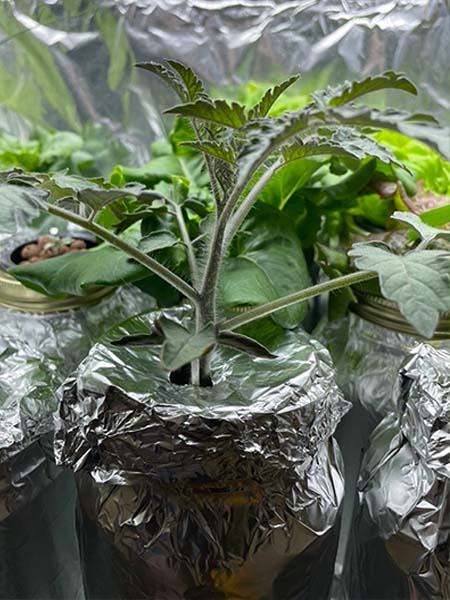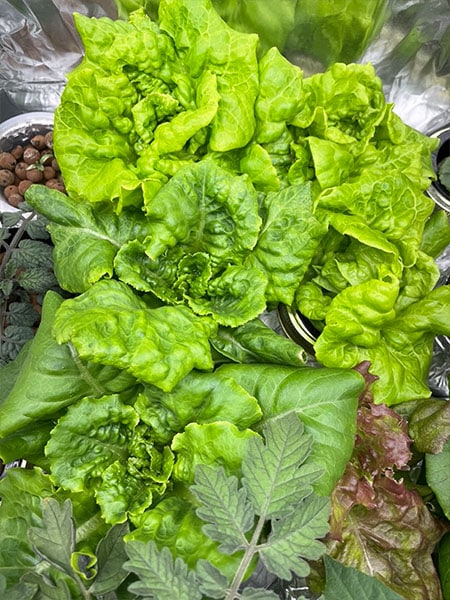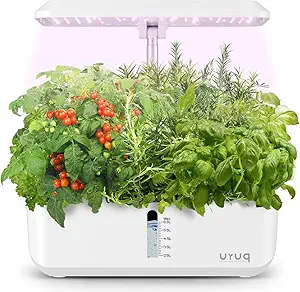Hydroponic Gardening
Why is hydroponic gardening the best growing method?
Hydroponic gardening is a great way to grow plants without the need for soil. It uses nutrient-rich water solutions and specific techniques to support plant growth and development. Soil-less growing means no dirt is needed, so there is no weeding and fewer pests to deal with.
Hydroponic gardening systems are more efficient than traditional gardening methods, They require less water, space, and labor. I grow 250+ pounds of fresh lettuce, tomatoes, basil, cilantro, peppers and even potatoes on 2 shelfs in my office. Literally 20 square feet. I even grew hydroponic strawberries inside during the winter months. Imagine picking a fresh strawberry from the vine. You can grow flowers and all sorts of herbs too.
I also find my hydroponic garden plants tend to be healthier with higher yields and faster growth rates. I am able to grow a head of lettuce for instance in just 30 – 45 days, ready for harvest direct to my table. In a traditional garden, lettuce would often 45 – 60 days. I can begin picking leaves sometimes as early as 21 days. With staggered planting techniques, this ensure I always have fresh crops to cultivate.
In the dead of winter, if you have an indoor hydroponic garden system, you can grow fresh fruits, vegetables, herbs and flowers all year long. All of these benefits make hydroponics an ideal choice for gardening . Not only is it a great way to grow food, but it’s also an exciting educational opportunity as well! Learning about how plants thrive in a soil-less environment can provide a unique and rewarding experience. Hydroponics is truly a hobby that anyone can enjoy – from beginners to experts alike!
Hydroponic gardening is exciting and great for kids

Hydroponic gardening provides an exciting opportunity to grow plants in a novel way. Whether you’re looking to save time and money, or just want to try something new, hydroponics is a great way to go! Plus, it’s fun and educational. The entire family can get involved and it is a great experience for kids. Our site was designed to help you get started growing hydroponic plants the Kratky way to begin growing plants with hydroponics.
The world of hydroponic gardening is an exciting one that can provide endless opportunities for learning, growth, and enjoyment. With the right setup and a little bit of knowledge, you can quickly become an expert in hydroponic gardening. Whether you’re looking to grow flowers or vegetables, hydroponics gives you the freedom to experiment and discover new techniques without having to worry about soil quality or other environmental factors. Plus, the lack of soil eliminates many of the traditional pests and diseases associated with gardening, making it a great choice for those who want to take their gardening hobby to the next level.
ADVERTISEMENT
Hydroponic gardening starter products on Amazon we recommend
These are the hydroponic gardening staples we recommend on Amazon. They are high-quality, will last a long time and will elevate your hydroponic garden results.
These net cups are great for hydroponic gardening and help the roots reach into the hydroponic garden solution.
These clay pebbles are great for hydroponic gardening and help the roots get air in your hydroponic garden.
These rock wools cubes are our favorite for hydroponic gardening and stimulate growth in your hydroponic garden.
These hydroponic container jar covers are our favorite for hydroponic gardening to stop algae in your hydroponic garden.
As an Amazon Associate I earn from qualifying purchases.
Hydroponic Gardening
Growing hydroponically is a great way to produce high-quality, nutritious fruits and vegetables in an efficient and environmentally friendly manner. By growing plants in nutrient-rich water instead of soil, you can reduce water usage, eliminate the need for chemical fertilizers, and increase yields. Plus, when done correctly it’s a very cost effective method because you don’t need to purchase soil or fertilizers. Hydroponic gardening also offers a great way for urban gardeners to participate in the farm-to-table movement, since you can grow food right in your own backyard.
Full Spectrum LED Lights: Supercharging Plant Growth
One of the most impressive features of modern hydroponic systems is their use of full-spectrum LED grow lights. These lights are designed to mimic natural sunlight, providing plants with the optimal light spectrum for photosynthesis. The URUQ system, for instance, boasts a 24-watt high-efficiency grow light that can accelerate plant growth up to five times faster than traditional soil-based methods.
What’s more, these systems often come with automatic timers that regulate light cycles, simulating natural day and night periods. The URUQ model provides 14-16 hours of “daylight” followed by 8-10 hours of “night,” ensuring your plants receive the perfect amount of light without any manual intervention.
ADVERTISEMENT
Hydroponics Growing System Indoor Garden: URUQ 12 Pods Indoor Gardening System with LED Grow Light Height Adjustable Plants Germination Kit Quiet Smart Pump – Hydroponic Planter Fresh Harvest White
The URUQ 12 Pods Indoor Gardening System is packed with innovative features to help grow fresh herbs, vegetables, and even flowers, 5 times faster than soil—thanks to their high-efficiency 24 Watt LED grow light. Whether you’re a seasoned gardener or just starting, you’ll love how easy and efficient this system is.
Hydroponic Gardening Tips
If you’re new to hydroponics and are looking for some advice on getting started, here are some tips to help you get started:
Select Hydroponic Style or Method
Figure out what type of hydroponic system you want to use. There are many different types of hydroponic systems available, so it’s important to educate yourself about the different options and decide which one is best for your needs.
Select Growing Medium
Select an appropriate growing medium. The type of growing medium you use will depend on the type of hydroponic system you choose.
Choose Which Plants to Grow
Decide which crops to grow. Hydroponics can be used for a variety of fruits and vegetables, so research what plants are best suited for your particular setup and climate.
Pick an Appropriate Nutrient Solution
Find the right hydroponic gardening nutrients. Different plants require different nutrient mixes, so find the ones that are best for your particular plants and system.
Setup Your Hydroponic System
Set up your hydroponic garden correctly. Make sure to follow instructions when setting up the various components of your hydroponic system to ensure it’s functioning properly and efficiently
Monitor and Adjust
Monitor and adjust your system as needed. Hydroponic gardening requires regular maintenance, so pay attention to the condition of your plants and nutrient levels.
Stagger Planting for Continous Harvests
If you do not need five heads of lettuce in one week, you’ll want to plan accordingly. Staggering your planting so you have a steady harvest of what you need each week.
Harvest and Enjoy
Enjoy the fruits of your labor! Once you’ve set up your hydroponic garden correctly, you can sit back and enjoy the delicious, nutritious fruits and vegetables you’ve grown.
ADVERTISEMENT
Hydroponic gardening growing systems can jump-start your hydroponic garden
For some, getting into hydroppnic gardening may seem overwhelming. Using a hydroponic gardening growing system can help get the new gardener started quickly, providing all of the materials needed in one kit.
As an Amazon Associate I earn from qualifying purchases.
Steps for Growing with Hydroponics
- Select a suitable medium, such as rockwool or clay pellets
- Understand nutrient solution and its components
- Set up a grow room with adequate light, temperature and humidity levels
- Learn about pH and EC values of water/nutrients used
- Monitor and adjust pH levels of nutrient solutions
- Choose the right plants for hydroponic gardening
- Create an adequate air and oxygen flow in your grow room
- Understand plant growth stages and manage them accordingly
- Harvest crops at their optimal time.
- Clean and maintain your hydroponic system regularly.
- Test the system for any pests or diseases regularly.
- Utilize beneficial bacteria to stimulate plant growth.
- Experiment with different techniques to improve crop yield. • Monitor water usage levels and adjust nutrients accordingly.
- Regularly check and adjust pH and EC levels.
- Consider using supplementary lighting for better crop growth.
- Research and understand the legalities of hydroponic gardening in your area. With these tips, you’ll be on your way to growing a successful hydroponic garden!
Hydroponic gardening is an efficient and sustainable way to produce food without the use of soil, relying instead on nutrient-rich water. It requires researching different system types and nutrient solutions, setting up a grow room with adequate light and temperature, managing pH/EC levels, maintaining the system, and understanding legalities in your area. With proper care and maintenance, you can enjoy fresh fruits and vegetables from your own hydroponic garden.
Hydroponic Gardening – Everything You Need to Know
If you’re interested in starting a hydroponic garden, there are a few things you should know before getting started. In this blog post, we’ll cover everything from the basics of hydroponic gardening to the different types of hydroponic systems. By the end, you’ll be ready to start your own hydroponic garden!
What is hydroponic gardening and how does it work?
Hydroponic gardening is a form of indoor gardening that relies solely on water, minerals, and hydroponics to nourish plants. Instead of using soil as a growing medium, hydroponics systems use mineral nutrient solutions to grow the plants. These solutions are often administered via sprinkler systems or drip irrigation in hydroponic greenhouses filled with sand, gravel, or rockwool. Once these hydroponic systems are set up, there is almost no maintenance needed for hydroponic gardens since the hydroponics solutions handle most of the nutrient delivery. That said, hydroponically grown plants do require periodic flushing of their systems to prevent buildup of salts and other elements that can potentially harm the plants. Hydroponic gardening offers several benefits to gardeners ranging from its efficient use of resources to its ability to facilitate year-round growing with little effort.
The benefits of hydroponic gardening
Hydroponic gardening is an indoor, soil-free gardening method that uses hydroponics to provide nutrients to the plants. The hydroponic system does not require any soil and uses a water reserve enriched with essential minerals. The hydroponic garden requires little maintenance and thus it provides a great option for gardeners who don’t have the time and resources to maintain a traditional garden. Furthermore, hydroponics use significantly less water than traditional gardening methods which makes it a more environmentally friendly choice. With hydroponics, you can even grow fruits and vegetables all year given access to light. Above all, hydroponic gardening allows you to reap higher yields of nutrient-dense produce in much shorter periods of time compared to soil-grown produce. If you are looking for a more convenient and sustainable way of growing vegetables and fruits at home, hydroponic gardening may just be the answer.
The different types of hydroponic gardening systems
Hydroponics is an innovational way to grow plants without the use of soil, instead relying on a nutrient-rich solution to provide nutrients. There are a number of different hydroponic systems that can be used depending on the type of plant being grown and the size of the growing space. Kratky hydroponics is a popular system where plants are suspended with their root systems in nutrient-filled water with no recycling or aeration system needed. This method uses minimal energy and can be used anywhere, making it ideal for those who want to try hydroponic growing but don’t have access to electricity or recirculated water. Other options include Deep Water Culture, Wick System and Ebb & Flow, each tailored to suit different types of plants. Hydroponic gardening has revolutionised the way we grow crops but careful consideration must be taken when deciding which system is right for your needs. We especially love the Kratky Method of Hydroponic Gardening.
How to set up a hydroponic garden
Hydroponic gardening is becoming an increasingly popular way to cultivate plants. All you have to do is light, air, hydroponic nutrients and a hydroponic growing medium to set up your hydroponic garden. Choose a hydroponic system that suits the species of plant you intend to grow and then assemble it according to the instructions. You’ll also need hydroponics solutions ready-made or prepared at home using water-soluble fertilizers designed specifically for hydroponics culture. The solution should be changed every 4-6 weeks to maintain nutrient levels within limits ideal for the plants in your garden. Finally, ensure the environment within your hydroponics system is closely monitored and adjusted as needed for optimum growth such as pH level of nutrient solutions, oxygenation and temperature. Taking some basic steps will help you get started with hydroponic gardening, quickly and easily!
Tips for successful hydroponic gardening
Hydroponic gardening is a great way to grow healthy and productive plants without soil. It involves using hydroponics – water, nutrients, and light – to help the roots of plants get the necessary elements for growth. There are a few tips that can help you have successful hydroponic gardening: make sure your hydroponic supplies are high-quality and suited for hydroponically growing plants; monitor pH levels and nutrient concentration in the hydroponic medium regularly; research hydroponically-compatible plants and determine their particular needs. By following these tips, you can ensure that hydroponics will provide you with healthy, vibrant plant growth!
FAQs about hydroponic gardening
If you’re interested in hydroponic gardening and are trying to learn all the ins and outs of hydroponics but don’t know where to start, look no further! FAQs about hydroponics provide answers to common questions asked by hydroponic enthusiasts such as “What are the different types of hydroponic systems?”, “Do I need expensive equipment to set up a hydroponic system?”, as well as more detailed questions like “Which hydroponic nutrients provide essential primary macro and micronutrients for most vegetables?” With an abundance of hydroponic resources available at your fingertips, you can find lots of useful information about hydroponics without having to worry about spending too much time researching. So get started today and unlock the many benefits that hydroponically grown plants have to offer!
Hydroponic gardening is a great way to grow plants without soil. The roots of the plants are submerged in water that has been enriched with nutrients. This method of growing plants can be done indoors or outdoors and has many benefits, such as not having to deal with pests or weeds, being able to control the environment, and producing high yields. There are different types of hydroponic systems, such as Deep Water Culture, Ebb and Flow, Nutrient Film Technique, drip irrigation, and wick systems. Setting up a hydroponic garden is relatively easy and only requires some basic knowledge about plumbing and electricity. With a little care and attention, your hydroponic garden will thrive. Are you a hydroponic gardener? Let us know in the comments.
ADVERTISEMENT
As an Amazon Associate I earn from qualifying purchases.












